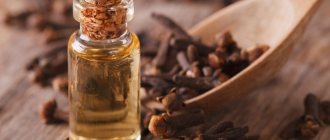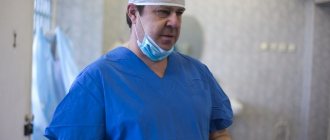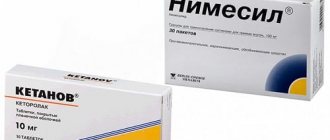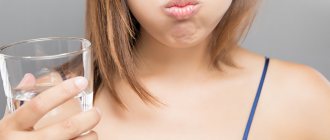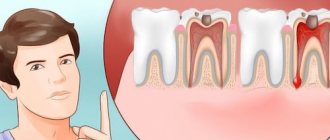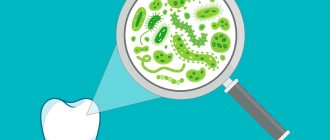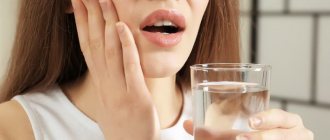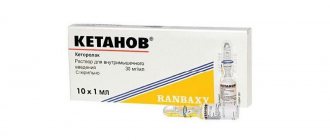Why does my tooth hurt?
The causes of toothache can be very different. Before dealing with pain, you need to understand where it came from.
- Caries. Unpleasant sensations can be caused by advanced caries, which has managed to spread deep into the enamel. Pain occurs when brushing teeth, exposure to cold or hot drinks or food.
- Pulpitis. This is an inflammation of the tooth tissue with an exposed nerve. Acute painful sensations can radiate to the ear, throat or temple. The pain often occurs at night.
- Flux. This is an infection that is characterized by swelling and hardening.
- Increased sensitivity. Thin tooth enamel may react poorly to exposure to cold, hot, and sweet foods. Pain also occurs when brushing your teeth.
- Inflammation. Characterized by swelling of soft tissues that compress the nerves. The pain intensifies when pressing on the gum.
- After removal of a dental unit. Normal pain is achy and may last for several days.
- Injuries. Damage to the enamel is characterized by chipping of the tooth and leads to exposure of the nerve. Because of this, severe pain occurs.
What is the effect of acupressure based on?
The acupressure technique is based on the ideas of Eastern sages about the structure of the human body. In ancient China, it was believed that 14 rivers of vital energy Chi flow through the human body. If they do not encounter obstacles, then with their flow they safely carry energy to all internal organs. But if a malfunction suddenly occurs and the organs receive Chi energy in different quantities, the person begins to get sick. Ancient doctors believed that balance could be restored by massaging certain points. This is how the Chinese technique of acupuncture appeared.
According to another Eastern theory, two principles are constantly fighting in the human body: the female Yin - changeable, cold, dark - and the male Yang - constant, warm, light. Balance can be achieved by applying pressure in the right places.
Rinse
Rinses are suitable for all categories of patients. They help relieve inflammation and reduce pain. You need to rinse your mouth with warm solutions. You can use ready-made mixtures that are sold in pharmacies, or prepare your own:
- Salt. 2 teaspoons per 1 glass of water. Relieves swelling, disinfects the oral cavity, neutralizes fungi.
- Oak bark. Boil 2-3 tablespoons of dry bark on the stove, cook for 5 minutes after boiling, strain and cool. The solution relieves pain and inflammation.
- Soda solution. Rinsing with soda reduces swelling and helps relieve discomfort that occurs during meals. Rinse with baking soda for 5–10 minutes.
Massaging technique: how to properly influence the points
Each point needs to be massaged in a special way. This way, getting rid of acute toothache will be as effective as possible.
- The He-gu point must be pressed with the thumb of the opposite hand. The duration of the procedure is from 2 to 3 minutes, until the skin turns red.
- In the area where the jaws close, the massage should be gentle so as not to damage the masticatory muscles. First, apply light pressure with your index finger, then make circular movements 30 times. Repeat until the toothache subsides, but no more than 5 approaches.
- To massage the point on the index finger, lightly press with your fingers 1 mm from the nail. The manipulation is continued until painful sensations occur.
- The area between the ring and middle fingers is applied with the tip of the nail. An unpleasant tingling sensation should appear.
- The wrist can be massaged for up to half an hour. Apply the thumb of the opposite hand and apply soft circular movements. You can also attach a piece of garlic or horseradish to the area.
The wrist can be massaged for up to half an hour.
Important! Do not be afraid that the location of the point is not determined accurately. The massage affects a wide area, so a deviation of a few millimeters will not play a significant role.
Treatment of acute toothache at home
It is not advisable to treat pain on your own. Any folk methods to alleviate it can only do harm. The best option is to visit a dentist as soon as possible so that he can provide timely treatment and stop the development of the inflammatory process.
In case of emergency, the following methods can be used:
- Cold compress. It can be applied to the cheek or aching tooth for a short time. Cold constricts blood vessels and delays the spread of inflammation. However, remember that you cannot hold a cold compress for a long time to prevent hypothermia.
- An aqueous solution of hydrogen peroxide 3% or a decoction of chamomile flowers (can be bought at a pharmacy). Rinsing helps remove pathogenic microflora; chamomile helps reduce inflammation.
- Compress with alcohol. Allows you to reduce pain for a while. Soak a cotton swab in alcohol and place it on the area affected by tooth decay.
Massage points on the face
How to find:
to the Jia Che point (see above) add two more symmetrical points, which are at the level of the earlobes, not reaching them 3 centimeters.
How to massage:
lightly touch with your index finger 10 times - first on one pair of points, then on the other.
How it works?
The Lin Dynasty Center has been practicing oriental massage for several decades, and its specialists are hereditary doctors who received the secrets of their craft from older relatives. By applying targeted pressure (stroking, pressing, rotating movements), doctors directly influence the blood flow, respiratory and digestive organs, restore the balance of energies in the body and promote overall health.
With acupressure, the doctor acts on points located on certain meridians, which include teeth, so toothache recedes. Most oral problems require a visit to the dentist, so we advise our clients to receive parallel treatment in our clinic and from a good dentist.
To make an initial appointment to create a long-term treatment plan or to sign up for a single session, call us or fill out the form on the website. We work every day except Sunday.
Acupressure method “lulls” pain
Centuries-old observations and practices of Chinese healers are described in medical treatises and provide an opportunity to become familiar with ancient massage techniques affecting human systems and organs. According to the theory of Eastern traditional medicine, the human body is covered with a network of points, the massage of which has a beneficial effect on well-being and health.
Acupressure is based on a principle similar to acupuncture. Bioactive points are affected by the fingers and their joints, which leads to the establishment of energy balance, reduction of muscle and nervous tension, reduction of pain, regulation of tissue trophism, and increased blood circulation.
Contraindications to acupressure
Contraindications for acupressure are as follows:
- feverish conditions;
- diseases of the blood and skin;
- presence of neoplasms;
- embolism and thrombosis;
- infectious and chronic diseases during periods of exacerbation;
- pregnancy.
This procedure is also contraindicated for children under two years of age.
Adviсe
The following tips will help you get the most out of your massage:
- It is advisable to wear loose clothing, as any restrictive clothing, such as belts, tight pants or even shoes, can restrict blood circulation.
- You should not massage right before meals or on a full stomach. Wait at least an hour after eating.
- Be sure to click in the right place. These points are very small, so you have to be precise. If you don't feel the effect, try changing the position of your finger.
- Stop if severe pain occurs.
Deterioration in health, increased body temperature, swelling of the face or bleeding are reasons to visit a doctor as soon as possible.
How to enhance the effect of acupuncture: basic recommendations
To get rid of toothache as effectively as possible using acupressure, adhere to the following recommendations:
- areas are massaged on the opposite side of the diseased tooth, unless otherwise indicated;
- before the manipulation, take a comfortable, relaxed position - sit down, lie down;
- first calm down, even out breathing: inhalations should be deep, exhalations should be long;
- mentally fully concentrate on the procedure;
- a repeat session is carried out at least half an hour later;
- After finishing the massage, it is advisable to wait a few minutes before doing other things.
Acupressure can only temporarily relieve pain.
Additional Information! To enhance the effect, you can perform the procedure with aromatic oils. Esthers of mint, cloves, lavender, and sage are suitable.
Acupuncture is used to relieve toothache when analgesics are not available. It is safe and suitable even for pregnant women and small children. But acupressure can only temporarily relieve discomfort. For complete treatment, you need to visit a dental clinic.
Additional technique
Another acupuncture technique was invented by Japanese specialist Yoshiro Tsutsumi. He developed a unique finger technique for maintaining health. Among his recommendations are tips for relieving toothache:
- Two points are identified on the outside of the palm. One is at the base of the index finger, where the phalanx attaches to the metacarpus. The second is at the line of intersection of the base of the thumb and index finger. You need to influence the areas with round hard objects - a tennis ball, a nut. Make 10 rotational movements, then press hard. Repeat 2 – 3 times.
- To determine the second point - Te-santri - draw a conditional line from the base of the thumb to the bend of the elbow, step down 1/5. You need to massage two areas at the same time. Hands clasp the elbows on the opposite side, make circular movements with the pads of the index and middle fingers.
The areas are massaged on the opposite side of the diseased tooth.
Acupuncture points for toothache relief
This method is based on oriental techniques and has stood the test of time for centuries.
Toothache can be caused by both caries and periodontitis, periostitis. It can occur suddenly and intensify when the tooth is exposed to a cold, hot, sour or sweet irritant. Acupuncture points for toothache can relieve toothache, but dental damage still needs to be treated later by a dentist.
The following points are most suitable for relieving acute toothache:
He-gu point (LI-4) (合谷, hé-gǔ - valley junction) - located on the dorsum of the hand in the depression between the bones of the thumb and index finger; Tai-si point (KD-3) (太谿, tài-xī - large flow) - on the leg in the cavity above the heel bone between the inner malleolus and the Achilles tendon; relieves pain in the upper teeth; Nei-ting point (ST-44) (内庭, nèi-tíng - inner courtyard) - on the front surface of the foot, anterior to the II and III metatarsophalangeal joints.
To treat toothache with acupressure, Chinese doctors recommended using many acupuncture points.
For pain in the teeth of the lower jaw:
Ju-gu point (LI-16) (巨骨, jù-gǔ - huge bone) - in the depression formed by the articulation of the sternum with the scapula; relieves pain in the lower teeth (main point); Xing-jian point (LV-2) (行間, xíng-jiān - between the knees) - on the outer surface of the foot between the I and II metatarsophalangeal joints (and slightly anteriorly), where the depression is felt; relieves pain in the lower teeth.
For pain in the teeth of the upper jaw:
Jia-che point (ST-6) (頰車, jiá-chē - chewing machine) - anterior and upward from the angle of the lower jaw, where a depression is felt; relieves pain in the upper teeth; Jie-si point (ST-41) (解谿, jiě-xī - open hollow) - on the dorsum of the foot in line with the second finger, where a depression is felt; relieves pain in the upper teeth; Tai-si point (KD-3) (太谿, tài-xī - large flow) - on the leg in the cavity above the heel bone between the inner malleolus and the Achilles tendon; relieves pain in the upper teeth; Er-men point (TH-21) (耳門, ěr-mén - ear gate) - in front and above the tragus of the ear, where the depression is palpated; relieves pain in the teeth of the upper jaw and pain radiating to the ear.
For pain in molars:
Jue-yin-shu point (厥陰俞, júe-yīn-shū - jue-yin point) - on the back at the level of the gap between the spinous processes of the IV and V thoracic vertebrae, 1.5 cm away from the midline ; relieves pain in molars.
For pain in the front teeth:
Jian-yu point (LI-15) (肩髃, jiān-yú - shoulder bed) - at the level of the fold of the wrist joint on the side of the thumb in the depression; relieves pain in front teeth; point Sy-du (TH-9) (四瀆, sì-dú - four rivers) - on the dorsum of the forearm below the olecranon 5 cm in the depression between the bones;
Relieves pain in front teeth well. Additional points (they can be massaged along with the main ones):
Qu-liao point (ST-3) (巨髎, jù-liáo - huge cleft) - in the nasolabial fold, at the point where it intersects with a vertical line drawn through the center of the pupil; point Di-tsang (ST-4) (地倉, dì-cāng - earthly storeroom) - 1 cm outward from the corner of the mouth, on a vertical line drawn from the pupil; Da-ying point (ST-5) (大迎, dà-yíng - large technique - anterior to the angle of the lower jaw; Xia-guan point (ST-7) (下關, xià-guān - lower border) - anterior to the tragus ear in the cavity; Nei-ting point (ST-44) (内庭, nèi-tíng - inner courtyard) - on the front surface of the foot, anterior to the II and III metatarsophalangeal joints; He-gu point (LI-4) (合谷, hé -gǔ - valley connection) - on the back of the hand in the depression between the bones of the thumb and index finger; Tien-rong point (SI-17) (天容, tiān-róng - heavenly reception) - below the base of the earlobe in the hole at the corner of the lower jaw; Ting-gong point (聽宫, tīng-gōng - palace of hearing) - between the tragus of the ear and the mandibular joint, where a depression is felt when opening the mouth; Kun-lun point (UB-60) (昆侖, kūn -lún - large and high) - in the depression between the posterior edge of the outer ankle and the Achilles tendon at the level of the center of the ankle; point (UB-62) (申脈, shēn-mài - extensible vessel) - below the outer ankle by 1, 5 cm, in the depression on the border of the plantar and dorsum of the foot; point (GB-2) (聽會, tīng-huì - hearing receiver) - anterior and inferior to the tragus of the ear, where the depression is palpable. Acupressure for toothache is quite capable of relieving the suffering of patients.
Table of acupuncture points - human meridians
| Name of human body meridian | Number of biologically active meridian points | Maximum meridian activity during the day | The relationship of the meridian to yang or yin energy | Transition of energy from meridian to meridian |
| Lung Meridian | 11 | from 3 to 5 o'clock | Yin | Passes into the colon meridian |
| Colon Meridian | 20 | from 5 to 7 hours | Jan | Passes into the stomach meridian |
| Stomach meridian | 45 | from 7 to 9 hours | Jan | Passes into the spleen-pancreas meridian |
| Pancreas Spleen Meridian | 21 | from 9 to 11 o'clock | Yin | Moves to the heart meridian |
| Heart Meridian | 9 | from 11 to 13 hours | Yin | Passes into the small intestine meridian |
| Small Intestine Meridian | 19 | from 13 to 15 hours | Jan | Passes into the bladder meridian |
| Bladder Meridian | 67 | from 15 to 17 hours | Jan | Moves to the kidney meridian |
| Kidney meridian | 27 | from 17 to 19 hours | Yin | Passes into the pericardial meridian |
| Pericardial meridian | 9 | from 19 to 21 hours | Yin | Passes into the meridian of three heaters |
| Meridian of three heaters | 23 | from 21 to 23 hours | Jan | Passes into the gallbladder meridian |
| Gall Bladder Meridian | 44 | from 23 to 1 hour | Jan | Passes into the liver meridian |
| Liver Meridian | 14 | from 1 to 3 hours | Yin | Passes into the lung meridian |
| Postomedial meridian | 28 | around the clock | Jan | Controls the Yang meridians |
| Anteromedian meridian | 24 | works during the period of greatest human activity | Yin | Controls the Yin meridians |
| Russian | French | German | English |
| Heart Meridian | Coeur - C | Herz-H | Heart - H |
| Small Intestine Meridian | Intestin grele - IG | Dunndarm - D.U. | Small intestine - Si |
| Colon Meridian | Grosintestin - GI | Dichdarm - Dd | Lange intestine - Li |
| Bladder Meridian | Vessie - V | Blase - B | Bladder - B |
| Kidney meridian | Renes - R | Niere - N | Kidney - K |
| Pericardial meridian | Pericard sexualis - MC | Kreislauf-sexus KS | Circulation-sex - Cx |
| Meridian of three heaters | Triple rechauffeur - TR | Drei-Heizer - 3E | Triple warmer - T |
| Gall Bladder Meridan | Vesicule biliaire - VB | Gallenblase - G | Gallbladder - G |
| Liver Meridian | Foix - F | Leber - Le | Live - Liv |
| Lung Meridian | Poumons - P | Lunge - Lu | Lungs - L |
| Stomach meridian | Estomac - E | Magen - M | Stomach - S |
| Spleen Meridian | Rate-Pancreas - RP | Milz-Pankreas - MP | Spleen - Sp |
| Anterior median meridian | Jenn-Mo - J (CON) | Conception - J.M. | Vassel of conception - CV |
| Posterior median meridian | Tou-Mo-T (VG) | Cuverneur - TM | Governing vassal - GV |
(LI)Large Intestine
All information on the site is for reference only and is not a public offer as defined by the provisions of Article 437 of the Civil Code of the Russian Federation.
MAIN INDICATIONS FOR THE PROCEDURE
- tired morphotype of the patient, tendency to pastosity;
- weakness of the ligamentous apparatus in the facial area;
- state of chronic stress, fatigue and malaise;
- aesthetic indications: wrinkles and folds, photo and chronoaging, deterioration of skin quality, oval deformation, vascular problems, hypersensitivity.
The procedure protocol uses points of general and local action, since the SUPER LIFT procedure also provides a general healing effect. Points of general action are located along the meridians: in the projection of the spinal column, on the arms and legs in the projection of large neurovascular bundles.
